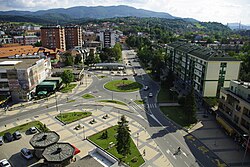Loznica
|
Лозница Loznica |
||||
|
||||
| Basic data | ||||
|---|---|---|---|---|
| State : | Serbia | |||
| Okrug : | Mačva | |||
| Coordinates : | 44 ° 32 ' N , 19 ° 14' E | |||
| Height : | 142 m. i. J. | |||
| Area : | 612 km² | |||
| Residents : | 26,203 (2002) | |||
| Agglomeration : | 86,413 (2002) | |||
| Population density : | 43 inhabitants per km² | |||
| Telephone code : | (+381) 015 | |||
| Postal code : | 15300 | |||
| License plate : | LO | |||
| Structure and administration (as of 2008) | ||||
| Community type: | city | |||
| Mayor : | Vidoje Petrović ( G17 Plus ) | |||
| Postal address : | Karađorđeva 2 15300 Loznica |
|||
| Website : | ||||
Loznica ( Serbian - Cyrillic Лозница ) is a town and municipality in the Mačva district in western Serbia . According to calculations by the Serbian Statistical Office, at the time of the 2011 census, the municipality had 84,925 inhabitants in an area of 612 square kilometers. The city itself had 19,672 inhabitants at the 2011 census.
geography
The municipality of Loznica is located on the eastern bank of the Drina River at its transition from the low mountain range to the lowlands formed by the Save . The town of Loznica is located on the Štira river at an altitude of 142 meters above sea level, about four kilometers east of the Drina. The highest point in the municipality is Mount Gučevo , which reaches a height of 770 meters.
At Loznica, the Drina forms the border with Bosnia and Herzegovina , where there is also a border crossing point.
Community structure
In the municipality of Loznica there are 54 settlements / districts in addition to the city itself. The places Klupci, Krajičnici and Lozničko Polje can be regarded as immediate suburbs of the city, with the city population reaching around 37,000 inhabitants. There is also the health resort of Banja Koviljača, about seven kilometers southwest of Loznica, in the municipality . The place Tršić, in which the philologist and reformer of the Serbian written language Vuk Stefanović Karadžić was born in 1787, is also of historical importance . The first letters of the variant of the Serbian-Cyrillic alphabet he developed can also be found in the municipality's coat of arms.
history
Finds point to the first settlements in the municipality by the Illyrians in the years of 900 BC. Until 300 BC The first documentary mentions date from the beginning of the 14th century. The name of the place is probably derived from the vineyards found here ( loza is the Serbian word for grapevine ). In 1834 the place received city rights. After there had been a primary school in town since 1795, the town received its first high school in 1858. In 1888 the city had a savings bank, a court and a hospital. From 1910 the city was connected to the railway network by the narrow-gauge railway Šabac – Banja Koviljača .
At the beginning of the First World War , the municipality was the scene of heavy fighting between the Serbian and Austrian troops. At the end of the war, Loznica moved from its former peripheral location to the center of the newly formed state through the formation of the Kingdom of Serbs, Croats and Slovenes . As a result, the city experienced a significant economic boom, as it was now on important trade routes from Belgrade and northern Serbia towards Bosnia. During the Second World War , 2,960 people were murdered in Draginac in October 1941 as an act of revenge by armed forces .
After the break-up of Yugoslavia in the early 1990s, tens of thousands of refugees came through the city as a result of the Yugoslav wars, especially from Krajina , Slavonia and Bosnia. Even today there are around 15,000 refugees in the municipality.
The Serbian Orthodox Ascension Church has been built north of the city center since 2002 .
Economy and Transport
Loznica is on the state road 18 from Šabac towards Užice and towards the Bosnian Zvornik .
The original narrow-gauge railway from Šabac to Banja Koviljača was converted to standard gauge in 1950 and extended to Zvornik. Currently (as of 2006), however, there is no passenger train service on the route.
The first viscose factory was built in Loznica in the 1950s . Today the economy is mainly determined by small and medium-sized companies in the field of trade. Agriculture contributes 30 percent to the municipality's economic power.
Personalities
The most important personalities in the history of the Loznica municipality include the Loznica-born geographer, geologist and anthropologist and later rector of the Belgrade University Jovan Cvijić (1865–1927) and the philologist Vuk Stefanović Karadžić (1787–1864), who was born in the village of Tršić whose work is based on today's Serbian script. The painter, filmmaker and educator Miodrag Popović (1923–1996) was also born in Loznica .
sons and daughters of the town
- Jovan Cvijić (1865–1927), Serbian-Yugoslav geographer
- Sinan Sakić (1956–2018), turbo folk singer
- Dragan Bartula (* 1959), contemporary painter
- Ivan Jovanović (* 1962), football player and coach
- Milinko Pantić (* 1966), football player
- Dragan Mićanović (* 1970), actor
- Goran Vujić (* 1982), musician
- Vladimir Stojković (* 1983), football player
- Zlatko Junuzović (* 1987), Austrian football player
- Jelena Stanković (* 1990), President AEGEE Beograd






